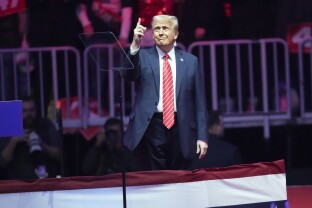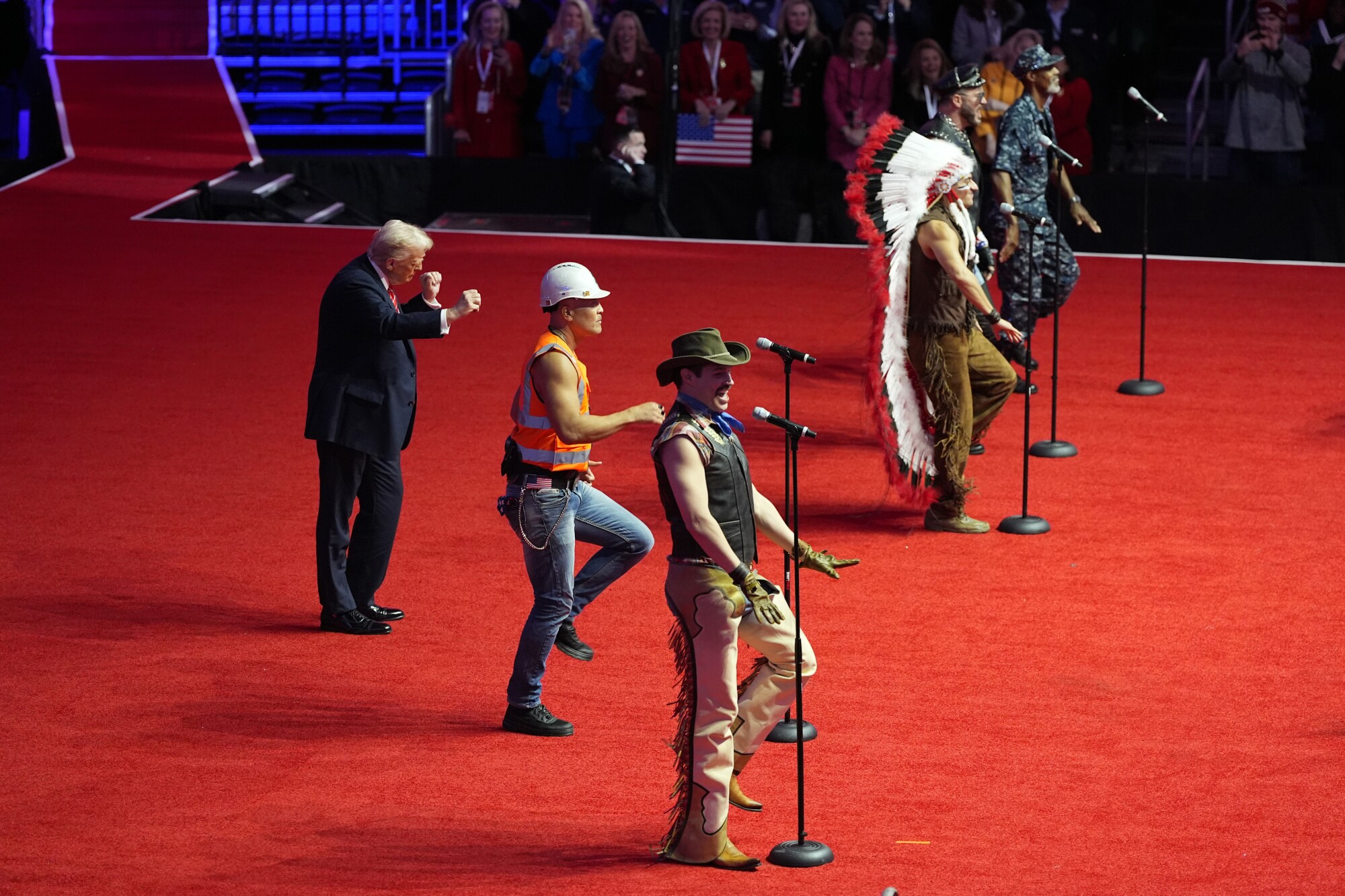After Donald Trump swore his oath to the nation eight years ago, his then-chief strategist Steve Bannon beelined straight to the White House — skipping the rest of the day’s pomp and celebration, intent on making sure all of the newly vetted executive orders were ready for the Washington newcomer’s signature.
“I was one of the first people in the White House, it still had boxes from the previous administration,” Bannon told NOTUS. That Inauguration Day was marked by chaos, miscommunication and fights over crowd size that left Washington declaring that Trump failed to deliver on his promises.
“The intensity of starting on Monday at noon for a new administration — particularly for us, since 2016 was such a come-from-behind victory — we didn’t really have a second to worry about transition until we actually won,” Bannon added.
Allies of the president-elect say that’s all over now. The senior team’s unfamiliarity with the government and infighting that fed a narrative of chaos for the first days won’t be present again, they say. This time around, Trump will take his oath and then enter the Oval Office far more ready to quickly transform the federal government.
Instead of the “shock and awe” strategy of 2017 — which included proclamations curtailing Obamacare, initiating a federal hiring freeze and withdrawing from a trade agreement — this time around the plans are bigger and have been in motion for months, if not years.
Trump will start with a host of prepared executive orders, which sources tell NOTUS could range in number anywhere between 70 and 100. The orders could be staggered throughout the week instead of all in one day. In addition to orders, he plans to sign dozens more executive actions, two sources told NOTUS — a different tool than an executive order that typically carries less legal weight. The full amount of new directives would reach over 200.
The strategy, said those who have knowledge of the plans, includes a flurry of action meant to show that Trump is serious about acting on the mandate he believes the American people bestowed upon him after the decisive November election.
“He wants to go to work and get a lot of things through to show the momentum, the swiftness in which he’s moving,” one GOP official said.
Bannon put it more bluntly.
“I say it’s bigger than shock and awe,” he said. “It’s gonna be days of thunder.”
The majority of the orders that have been written and that Trump might choose to sign fall under one of several issue buckets, including immigration, energy, tariffs, cultural issues like DEI and return to work, as well as crypto, Big Tech, Jan. 6 defendants and TikTok.
For instance, Trump told senators during a Sunday morning breakfast at Blair House that he planned to repeal Joe Biden’s electric vehicle mandate on the first day, amid other orders that would focus on the border and drawing back other regulations, according to a source familiar with the conversation.
And in a midday call with lawmakers, his team expanded on what’s to come, according to two sources briefed. Stephen Miller, the incoming deputy chief of staff who will also oversee domestic policy, said Trump would move to revive key policies he put in place in his first administration — like Schedule F, making it easier for federal employees to be fired — while tearing down new policies erected by Biden.
The orders, many of which were drafted in a shroud of secrecy, are just the start of an administration on a mission to maximize its first 100 days in office — some orders might be substantive directives, while others might be solely for messaging.
Frank Maisano, a senior energy lobbyist at Bracewell, said executive orders are often “symbolic in nature.”
“They set a tone for what an administration wants to project as their agenda and their direction, right,” he said.
But a former top aide suggested Trump is trying to do more than just table setting. “The first priority isn’t the messaging, it’s the doing,” said Ken Cuccinelli, who had been a senior Homeland Security official in the first term. “I think to the extent messaging is on the list, it’s to convey that he’s going to keep his promises, which was one of his strengths in his first term, which is not necessarily something that always happens in Washington.”
Sen. Markwayne Mullin, a close friend of Trump’s who has been briefed on what’s coming, summed the expected orders up as a way to “jump start” Trump’s agenda.
In an interview on Friday, Mullin told NOTUS to expect orders on the border, national security and energy. “Those are going to be the three big areas. You may see some stuff on foreign policy that’s directed depending on what happens, you know, in Israel and Gaza, but that’s to be determined.”
Many of the nearly dozen officials, operatives, allies and staff NOTUS spoke with say the biggest swing could be reviving Trump’s 2019 executive order “Remain in Mexico,” which required certain immigrants seeking asylum along the southern border to wait in Mexico. Biden ended the policy in his first year in office, but faced lawsuits looking to reinstall it. Others expect Trump to bring back Title 42, a controversial pandemic-era law that allowed the government to expel those who had come from countries where a contagious and passable disease was present.
“There will be impacts, literally, at 12:01 p.m.,” Cuccinelli told NOTUS. “The Border Patrol will immediately be converted from the world’s biggest force of greeters outside of Walmart to a law enforcement organization again who’s tasked with defending the border. That literally happens simply by the swearing in of Donald Trump.”
Miller and border czar Tom Homan have led the most recent drafting of EO’s since the election. But that’s after Trump’s allies — including in think tanks like America First Policy Institute and The Heritage Foundation — have spent years studying possibilities.
One person with insight into the process said that the major swings on immigration — including the pledge to deport migrants who have crossed the border illegally, with a focus on those who have committed crime while in the United States — may not begin in earnest until the Senate confirms Trump’s pick to lead the Department of Homeland Security, South Dakota Gov. Kristi Noem.
“I know that they have plans and are ready to rock and roll, but they also want to give some time for Noem to get in and get settled a little bit,” the source said.
Two Republican officials outside of the transition team NOTUS spoke with said they expect Trump to sign an order that kicks off the fight to get federal workers back in the office five days a week, after the pandemic pushed people out of the office and created a work-from-home model for many government workers.
Another major issue that Trump is likely to deal with on day one is the fate of TikTok. Trump acknowledged as much himself on Sunday, saying on Truth Social that he would issue an executive order to keep the app live in the U.S. after a law banning it or forcing its sale went into effect.
A GOP official with direct knowledge said that TikTok pitched Trump on three options to keep the app online in the U.S., after the Supreme Court upheld the law on Friday. They include effectively ignoring the law by the Department of Justice not enforcing it as passed, certifying that TikTok had qualified the divestment statute by offloading its infrastructure to the American company Oracle, or by simply issuing a 90-day extension.
Trump suggested on Truth Social that he would issue an extension.
A major crypto executive order is also expected, according to two sources. One option, Reuters reported, is to create an advisory council. And orders on artificial intelligence are also expected to come down, some meant to reverse Biden’s last-ditch efforts that erected guardrails on AI use.
AI isn’t the only place Trump and his team plan to reverse Biden-era policies.
“You’re going to see laws that Biden overturned will be reimplemented,” Mullin said. He added that applied to national security, regulation and executive orders on energy, like “when it comes to public land and permitting and the stuff that happened offshore, and maybe even Alaska.”
Trump reiterated that promise at a rally on Sunday night.
“Somebody said yesterday, ‘sir, don’t sign so many in one day, let’s do it over a period of weeks.’ I said, ‘like hell we’re gonna do it over weeks. We’re gonna sign them at the beginning,’” Trump told his supporters at Washington’s Capital One Arena.
But they’ll have to tread carefully. House GOP leadership has asked the Trump team to not rescind all Biden-era policies via executive orders, according to a senior aide. It’s not that House Republicans love the Biden policies — they just might need to own their reversals themselves. As Punchbowl News first reported, some lawmakers are hoping to rescind Biden policies during the reconciliation process and have it count toward spending cuts that conservative lawmakers say they need to see before they agree to new spending.
But for Bannon, who has been inside the driver’s car before on a day like this and will now work from the outside, the first day is one of many that can make or break a legacy.
“You understand the weight of history that’s on you and the country,” he said. “Whatever administration, it’s a ton of pressure because you’ve now relieved the watch, and whatever happens, you know you’re responsible for, and you’re gonna be held accountable for it.”
—
Jasmine Wright and Reese Gorman are reporters at NOTUS.
This site is protected by reCAPTCHA, and the Google Privacy Policy and Terms of Service apply. By continuing on NOTUS, you agree to its Terms of Use and Privacy Policy.
Sign in
Log into your free account with your email. Don’t have one?
This site is protected by reCAPTCHA, and the Google Privacy Policy and Terms of Service apply. By continuing on NOTUS, you agree to its Terms of Use and Privacy Policy.
Check your email for a one-time code.
We sent a 4-digit code to . Enter the pin to confirm your account.
New code will be available in 1:00
Let’s try this again.
We encountered an error with the passcode sent to . Please reenter your email.
This site is protected by reCAPTCHA, and the Google Privacy Policy and Terms of Service apply. By continuing on NOTUS, you agree to its Terms of Use and Privacy Policy.



